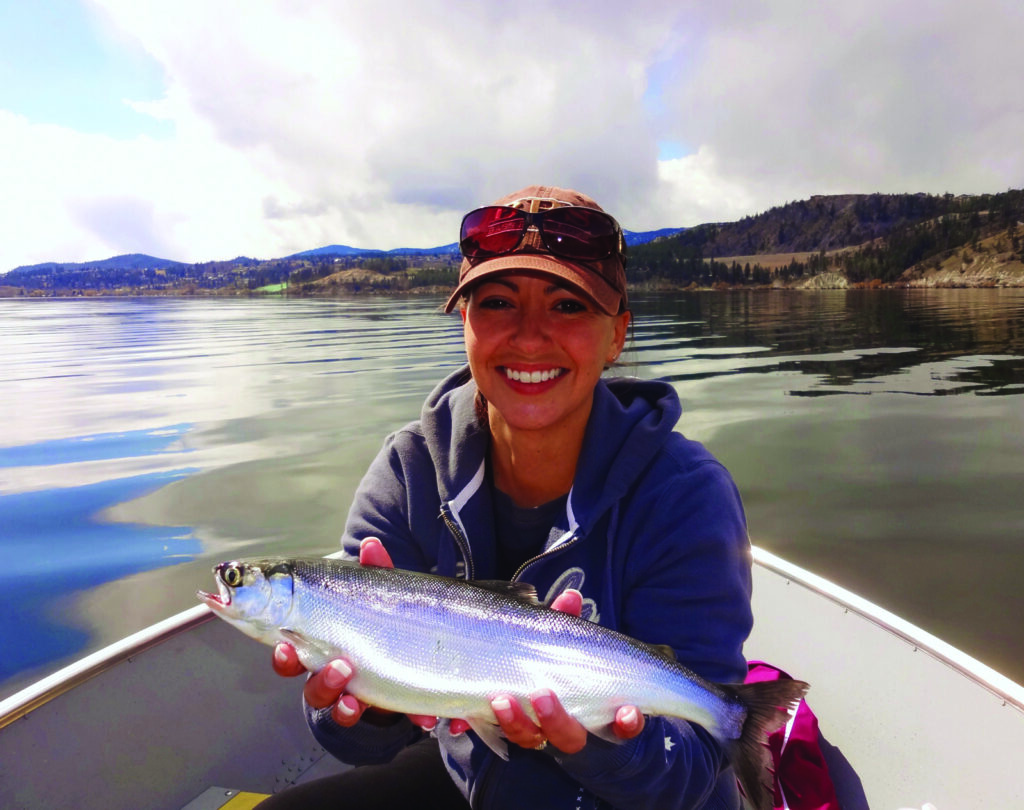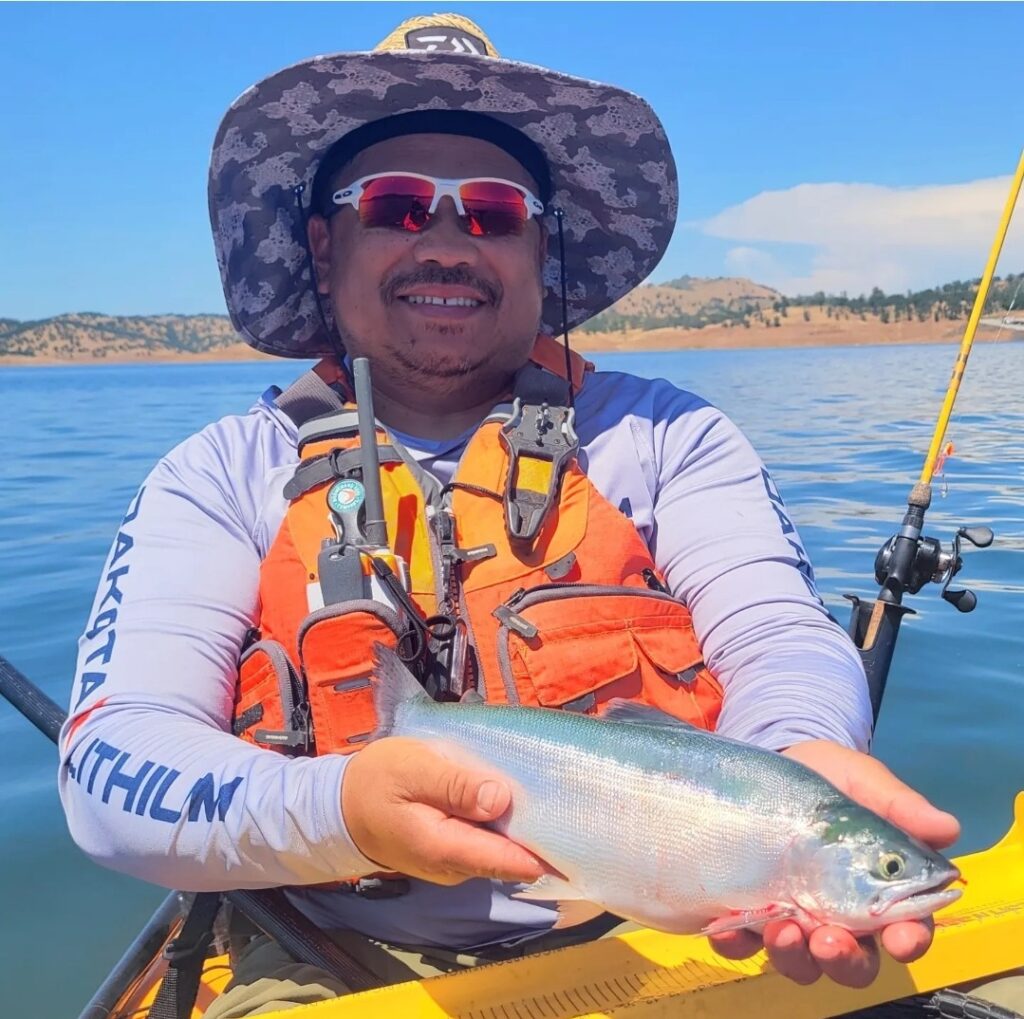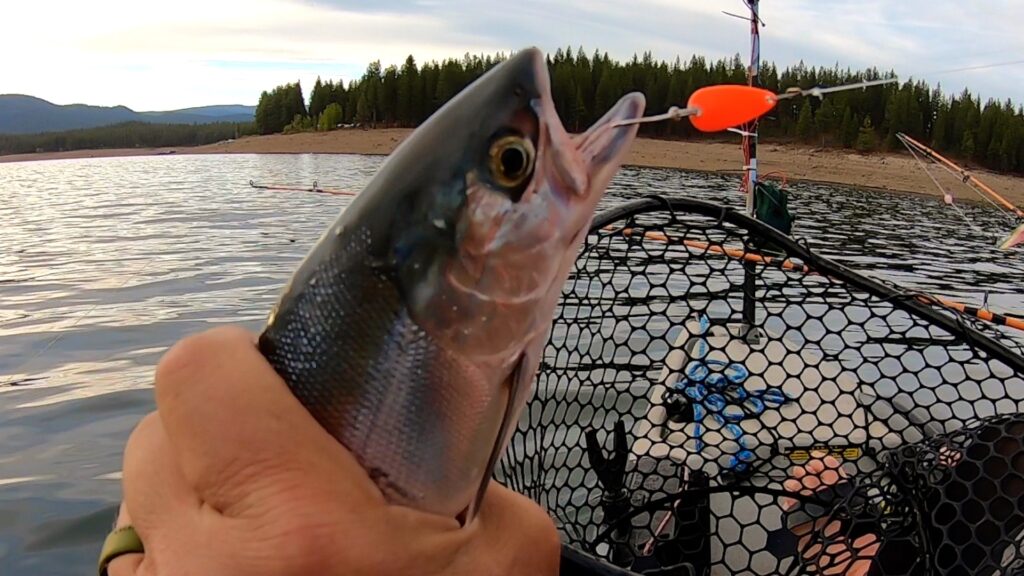Kokanee: The Salmon Alternative For California Anglers
The following appears in the May issue of California Sportsman:

By Cal Kellogg
I’m not one of those guys that goes fishing but doesn’t eat fish. On the contrary, I’m one of those anglers that often goes fishing to put fish on the table and in the freezer.
One of the species I really look forward to targeting and eating is ocean-run king salmon, but alas, there will be no tasty Chinook filets coming out of California waters this summer now that a statewide ocean salmon closure is a reality and the Department of Fish and Wildlife also recently closed Central Valley rivers and the Klamath close to fishing as well.
What’s a California angler craving some sport and a salmon dinner to do? Drive up to the far-flung waters of Oregon or Washington? Fly to Alaska? Settle for the farm-raised flavorless salmon sold at the supermarket?
Luckily for us, farsighted conservation groups like Kokanee Power and Project Kokanee, working in conjunction with the California Department of Fish and Wildlife (then known as California Fish and Game), set the stage for Golden State anglers to have constant access to hard-fighting, great-eating salmon decades ago when they fought to keep kokanee planting a reality in California reservoirs.
You see, while kokanee had been introduced to California waters prior to World War II, in the early 1980s, CDFG was ready to scrap the stocking program, citing cost and lack of angler interest.
Men like Hal Bonslett, founder of the old Fish Sniffer magazine, Dan Bacher, well-known fishery conservation advocate, and Sep Hendrickson, who would become perhaps the most influential freshwater fishing tackle manufacturer of a generation, recognized the potential of a California sport fishery for landlocked sockeye salmon.
These individuals, along with a long list of others, took action, convincing CDFG to continue kokanee plants. They raised money to help fund the expansion of kokanee stocking. In addition, Hendrickson played a central role in developing light-tackle lake and reservoir trolling techniques and equipment.
Without Hendrickson, those big aluminum sleds arrayed with downriggers and wispy light-action rods that you see dotting reservoirs in Northern and Central California as they ply deep waters for kokanee, landlocked kings and trout likely wouldn’t exist!
While kokanee certainly don’t grow as big as ocean salmon, landlocked sockeye have thrived in Golden State waters over the past four-plus decades, to the extent now that anglers who like salmon filets featured on their tables can say, “No ocean salmon, no problem! I’ll just harvest a few limits of kokanee this spring and summer.”

AS FUN AS KOKANEE are to catch, they are a quirky gamefish both in what they are willing to strike and in terms of where you’ll find the best fishing from year to year.
The bigger the kokanee, the bigger the fight and the more meat they produce, so anglers are motivated to target the biggest ones they can find. However, big kokanee are a moving target due to their quirky nature.
If a reservoir has too few kokanee, it will produce a few really large fish, but they won’t exist in numbers large enough to target. Englebright Reservoir in the Sierra foothills east of Marysville is an example of this.
Englebright isn’t planted with kokanee, but a few sockeye from Bullards Bar Reservoir find their way downstream into Englebright. I’ve seen kokanee beyond 20 inches landed at Englebright by trout trollers, but despite repeated attempts, I’ve never been able to target kokanee at the lake. There simply isn’t a big enough biomass of salmon to selectively target them.
On the other hand, at reservoirs such as Bullards Bar, where kokanee are able to spawn naturally in the reservoir’s tributaries, it’s easy for the salmon to become overpopulated. When this happens you end up with clouds of small fish.
Several years ago, the limit at Bullards was increased from five fish to 10 in an attempt to bring down the total population and increase the average size of the fish, but thus far a big kokanee at Bullards is 12 inches, while rank-and-file sockeye run a diminutive 10 to 11 inches.
For several years, Lake Berryessa was the place to go for big kokanee in the 17- to 21-inch class, but that fishery collapsed and is in a state of rebuilding. Prior to Berryessa wearing the crown, far to the north, Whiskeytown Reservoir was the place to head for a 20-plus-inch silver bullet.
Stampede Reservoir near Truckee was once a reliable destination for 16- to 18-inch kokanee before becoming overpopulated with small fish, but recently Stampede has bounced back, and the average size of the salmon being caught has been on the upswing for several years.
OK, ENOUGH WITH THE history lesson. While kokanee can be caught in California during any month of the year, the period between May 1 and the end of August marks the sweet spot of the fishery, when the salmon are at their largest and access is easy even at high-elevation lakes that spend a good part of the year locked in snow.
This being the case, let’s take a deep dive and consider the best lakes for harvesting big kokanee this summer, then I’ll touch on tackle considerations for any rookie kokanee anglers in the audience.

NEW MELONES RESERVOIR
New Melones is going to produce the largest kokanee of the year for California anglers. Kokanee are averaging over 16 inches already and fish approaching 19 inches have been landed. Sockeye exceeding 20 inches should be showing up during June.
New Melones is located in Angels Camp – home of the Jumping Frog Jubilee author Mark Twain made famous – in Calaveras County on the Stanislaus River. The lake features 12,500 surface acres of water and 100 miles of shoreline when full. The elevation is 1,088 feet when full.
New Melones has down years for kokanee just like every other fishery, but it has a tradition of producing impressive kokes. The largest California kokanee I’ve ever seen grabbed a corn-tipped Apex here during an early 2000s trolling adventure. Measuring over 22 inches and weighing just shy of 4 pounds, it was a magnificent brute that looked like something you’d hook fishing a coastal river in Alaska!

WHISKEYTOWN LAKE
Whiskeytown kokanee likely won’t hit the 20-inch mark this season, but some will come close. My buddy Captain Kirk Portocarrero has already landed multiple fish between 16 and 17 inches this spring. He told me the salmon are thick-bodied and very energetic.
The lake, located east of Redding off Highway 299 in the Trinity Mountains, offers 36 miles of shoreline and 3,200 surface acres of water. Of the three parts of the Whiskeytown-Shasta-Trinity National Recreation Area, the Whiskeytown Unit is the only one administered by the National Park Service.
President John F. Kennedy visited Whiskeytown Reservoir just before his assassination in 1963 and made remarks about the completion of the dam. An interactive memorial is in place commemorating the visit.
I’ve always enjoyed fishing Whiskeytown’s crystal-clear waters. The lake is almost always brimful. In addition to the kokanee, you’ll also encounter rainbow and brook trout. Traditionally the Highway 299 Bridge and the area in front of the dam are the best spots to target sockeye.


STAMPEDE RESERVOIR
Stampede’s kokanee are robust spawners; in fact, all hatchery kokanee in California either come from Stampede Reservoir or Lake Tahoe. Since Stampede’s kokanee spawn so successfully, there is always the risk of overpopulation. This situation occurred a few years back, resulting in a massive biomass of 10- to 12-inch salmon.
The days of excess salmon seem to have passed. Last year, the average fish went about 15 inches, with some 16- and 17-inchers caught. This year, Stampede kokanee should add another inch in terms of average size, making for some very exciting action.
Stampede is located a few miles east of Truckee on the eastern slope of the Sierra Nevada. The lake sits at an elevation of about 6,000 feet. With 3,340 surface acres at full capacity, the lake is fairly small by California reservoir standards, but when measured against a lot of other waters at Stampede’s high elevation, it is actually pretty large.
If you are a small-boat angler, be aware that Stampede is subject to stiff winds almost every afternoon during the summer. The bite can be good when the wind is pushing and whitecaps are building, but always think safety when boating in the high Sierra.

KOKANEE PREFER COLD WATER, so when the surface temperature begins rising in late spring, the fish respond by dropping down in the water column. For this reason, you’ll want a decent sonar unit to locate the salmon and a set of downriggers to get your lures down to the level of the fish.
Electric downriggers are awesome, but simple manual crank downriggers are highly effective and won’t put a big dent in your allowance.
For a lot of freshwater fishing, a fast- or medium-fast-action rod works best, but for kokanee, the most effective and efficient rod will feature a soft, slow parabolic action. Kokanee are savage little sluggers that have an exceedingly soft mouth. A soft-action rod helps to cushion the fight and results in fewer lost fish.
The rod should be balanced with a levelwind reel spooled wmall hoochies, and hooks adorned with brightly painted resin and which are known as “bugs.”
Orange and pink lures are favorites among kokanee enthusiasts, but it pays to have a wide range of color combinations; kokanee that wanted a pink lure at dawn may prefer a green one later in the morning.
Most kokanee trollers employ small dodgers with their lures, but some use modern low-drag flashers too. While larger dodgers in the 6-inch class work at times, I prefer those from 3 to 4 inches long. These are large enough to attract kokanee to the lure, but not large enough to scare them.
Speaking of not scaring kokanee, chrome dodgers generally work well when the light level is low, but the extreme flash they put off when the sun is high can often frighten kokanee and put them off the bite.
It’s wise to have some blades in colors like copper, gold, pink, orange and watermelon to mix into your spread when the kokanee shy away from chrome dodgers in the late morning hours.

IN CALIFORNIA, ALMOST ALL kokanee anglers tip their lures with shoepeg corn, and it makes a huge difference in productivity. No one is certain why you need to use corn. Some say it adds a pleasant smell to the lure. Others contend that it gives the salmon a target to strike.
A lot of skilled kokanee anglers add scent to their corn. Some days kokanee want shrimp-scented corn; other days they prefer anise. Anise, krill, tuna, herring, sardine, garlic and nightcrawler scents are all proven performers.
I like to bring four Ziplock bags of corn, each bathed in a different scent, so I can determine what is working the best on the day I’m fishing. Be sure to leave some corn unscented. Sometimes, the right corn comes straight out of the can! CS



